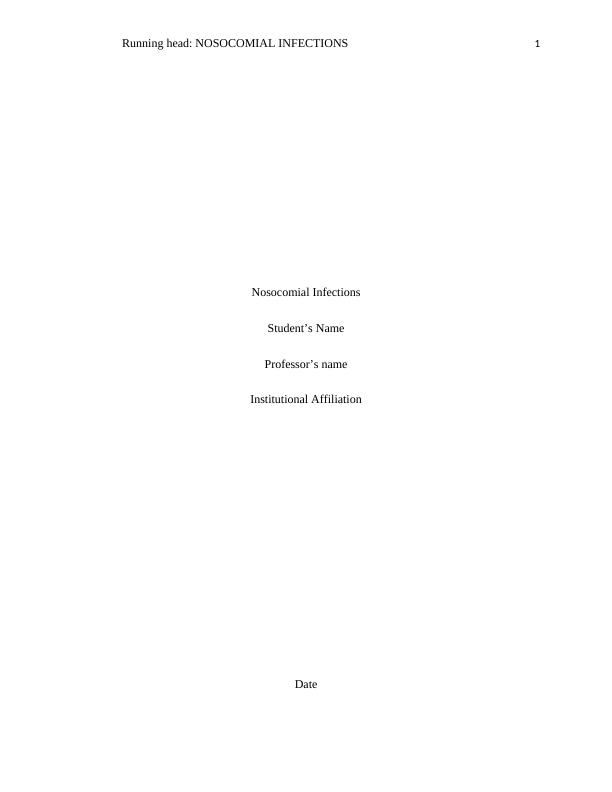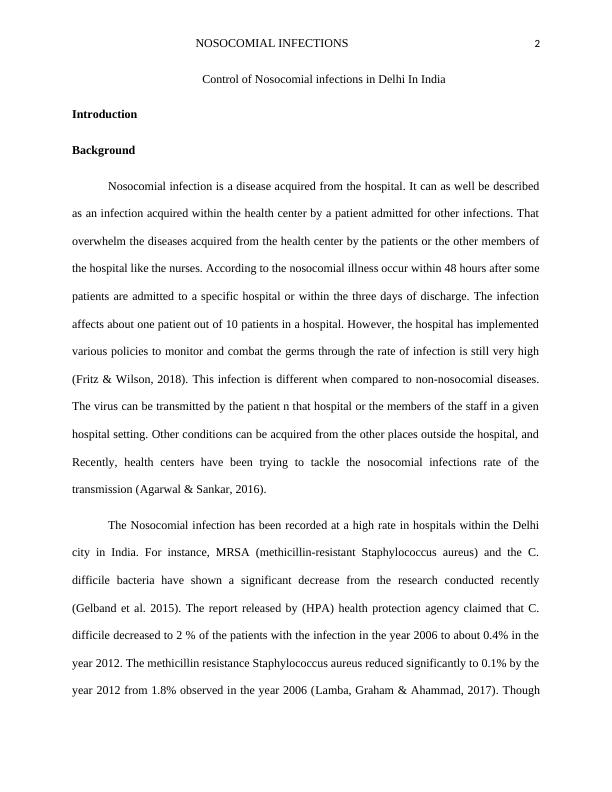Control of Nosocomial infections in Delhi In India
Added on 2023-06-11
12 Pages3168 Words371 Views
Running head: NOSOCOMIAL INFECTIONS 1
Nosocomial Infections
Student’s Name
Professor’s name
Institutional Affiliation
Date
Nosocomial Infections
Student’s Name
Professor’s name
Institutional Affiliation
Date

NOSOCOMIAL INFECTIONS 2
Control of Nosocomial infections in Delhi In India
Introduction
Background
Nosocomial infection is a disease acquired from the hospital. It can as well be described
as an infection acquired within the health center by a patient admitted for other infections. That
overwhelm the diseases acquired from the health center by the patients or the other members of
the hospital like the nurses. According to the nosocomial illness occur within 48 hours after some
patients are admitted to a specific hospital or within the three days of discharge. The infection
affects about one patient out of 10 patients in a hospital. However, the hospital has implemented
various policies to monitor and combat the germs through the rate of infection is still very high
(Fritz & Wilson, 2018). This infection is different when compared to non-nosocomial diseases.
The virus can be transmitted by the patient n that hospital or the members of the staff in a given
hospital setting. Other conditions can be acquired from the other places outside the hospital, and
Recently, health centers have been trying to tackle the nosocomial infections rate of the
transmission (Agarwal & Sankar, 2016).
The Nosocomial infection has been recorded at a high rate in hospitals within the Delhi
city in India. For instance, MRSA (methicillin-resistant Staphylococcus aureus) and the C.
difficile bacteria have shown a significant decrease from the research conducted recently
(Gelband et al. 2015). The report released by (HPA) health protection agency claimed that C.
difficile decreased to 2 % of the patients with the infection in the year 2006 to about 0.4% in the
year 2012. The methicillin resistance Staphylococcus aureus reduced significantly to 0.1% by the
year 2012 from 1.8% observed in the year 2006 (Lamba, Graham & Ahammad, 2017). Though
Control of Nosocomial infections in Delhi In India
Introduction
Background
Nosocomial infection is a disease acquired from the hospital. It can as well be described
as an infection acquired within the health center by a patient admitted for other infections. That
overwhelm the diseases acquired from the health center by the patients or the other members of
the hospital like the nurses. According to the nosocomial illness occur within 48 hours after some
patients are admitted to a specific hospital or within the three days of discharge. The infection
affects about one patient out of 10 patients in a hospital. However, the hospital has implemented
various policies to monitor and combat the germs through the rate of infection is still very high
(Fritz & Wilson, 2018). This infection is different when compared to non-nosocomial diseases.
The virus can be transmitted by the patient n that hospital or the members of the staff in a given
hospital setting. Other conditions can be acquired from the other places outside the hospital, and
Recently, health centers have been trying to tackle the nosocomial infections rate of the
transmission (Agarwal & Sankar, 2016).
The Nosocomial infection has been recorded at a high rate in hospitals within the Delhi
city in India. For instance, MRSA (methicillin-resistant Staphylococcus aureus) and the C.
difficile bacteria have shown a significant decrease from the research conducted recently
(Gelband et al. 2015). The report released by (HPA) health protection agency claimed that C.
difficile decreased to 2 % of the patients with the infection in the year 2006 to about 0.4% in the
year 2012. The methicillin resistance Staphylococcus aureus reduced significantly to 0.1% by the
year 2012 from 1.8% observed in the year 2006 (Lamba, Graham & Ahammad, 2017). Though

NOSOCOMIAL INFECTIONS 3
there still other bacteria on rise especially those caused by E. coli and the salmonella. The
research has shown the mutual infections affect the respiratory tracts succeed by the urinary tract
diseases and the surgical sites infections (Kumar et al 2017). It’s also clearly indicated that
within Delhi the highest number of people affected by the nosocomial infections are the old
people and the infants. The high rate of infections was recorded within the intensive care unit
(ICU) and the surgical wards (Gupta, Krishnan, Sharma, Kumar, Aneja & Ray, 2018)
Hospital in Delhi in India carry a significant burden of these infections, and the diseases
are continuously affecting individuals at a high rate. Thus, making it the choice of my research
site. Many of these infection within this locality are antibiotic-resistance to the treatment. This is
with the respect to (GARP) global antibiotic resistance partnership for the India working groups.
The report released by GARP stated that many of these nosocomial diseases can be prevented.
Therefore, the primary objective of this report is to focus on how these nosocomial infections can
be significantly reduced within Delhi's hospitals. The research conducted in the hospitals within
Delhi in India has revealed that the rate of VRE (vancomycin-resistant enterococcus) and MRSA
resistance rate is exceptionally high compared with the other world hospitals (Gelband et al.
2015).
The fact that these nosocomial infections resistance to the antibiotic are a significant
challenge in treatment. The negative results of these infections are a prolonged period of stay in
hospitals, more treatment expenses, and death in most cases. The global antibiotic resistance
partnership (GARP), Delhi hospitals contribute a higher number of deaths associated with some
nosocomial infections. Another research study carried out in the year 2001 in one of the hospitals
in the Delhi city suggested that about 140 out of the possible 1253 people accounting for 11
percentage in 152 health centers had the infections. Some research proved that many hospitals in
there still other bacteria on rise especially those caused by E. coli and the salmonella. The
research has shown the mutual infections affect the respiratory tracts succeed by the urinary tract
diseases and the surgical sites infections (Kumar et al 2017). It’s also clearly indicated that
within Delhi the highest number of people affected by the nosocomial infections are the old
people and the infants. The high rate of infections was recorded within the intensive care unit
(ICU) and the surgical wards (Gupta, Krishnan, Sharma, Kumar, Aneja & Ray, 2018)
Hospital in Delhi in India carry a significant burden of these infections, and the diseases
are continuously affecting individuals at a high rate. Thus, making it the choice of my research
site. Many of these infection within this locality are antibiotic-resistance to the treatment. This is
with the respect to (GARP) global antibiotic resistance partnership for the India working groups.
The report released by GARP stated that many of these nosocomial diseases can be prevented.
Therefore, the primary objective of this report is to focus on how these nosocomial infections can
be significantly reduced within Delhi's hospitals. The research conducted in the hospitals within
Delhi in India has revealed that the rate of VRE (vancomycin-resistant enterococcus) and MRSA
resistance rate is exceptionally high compared with the other world hospitals (Gelband et al.
2015).
The fact that these nosocomial infections resistance to the antibiotic are a significant
challenge in treatment. The negative results of these infections are a prolonged period of stay in
hospitals, more treatment expenses, and death in most cases. The global antibiotic resistance
partnership (GARP), Delhi hospitals contribute a higher number of deaths associated with some
nosocomial infections. Another research study carried out in the year 2001 in one of the hospitals
in the Delhi city suggested that about 140 out of the possible 1253 people accounting for 11
percentage in 152 health centers had the infections. Some research proved that many hospitals in

NOSOCOMIAL INFECTIONS 4
Delhi do not adhere to infection-controlled measures hence contributing to the high rate of the
nosocomial diseases spread (Sharma, Ramani, Mavalankar, Kanguru & Hussein, 2015).
Analysis of the issue
In order to Control of the spreads of the nosocomial infections, there is need to
understand how these infections are transmitted. Nosocomial infection is as a result of the
microorganisms present within the hospital surroundings. The transmission of the disease
between the nurses and the patient with a weak immune system. When the infection is
transmitted from one person to another, the infection is referred to as exogenous infections. The
transmission could happen for instance when the nurse has to apply the bandage to the wounds of
the patient and moves to attend the next patient without disinfecting their hands. In case there are
any infection-causing bacteria present, it can be transmitted to the nurse or the next patient (Kalil
et al. 2016).
Nosocomial infections can also occur as a result of self-infection hence known as
endogenous infection which is an infectious component within individual's body. Such
contagious elements are the UTIS within the digestive tract. The growth of such bacteria is being
facilitated by the proper environmental condition that favors its growth. These conditions are like
water, nutrients, oxygen, and darkness. For many individuals within the Delhi city, acquire
nosocomial infections when an individual is still admitted to the health center. These peoples'
immune system is compromised thus unable to prevent the disease. The most individuals prone
to nosocomial infection other than the old and the infants are the people who have cancer. These
are the individuals who lost their lifetime undergo chemotherapies for cancer treatment since it
has been proven the various therapies decrease the rate of white blood cells (WBCs). The
reduction of the WBCs weakens the immune system since their primary purpose is to fight
Delhi do not adhere to infection-controlled measures hence contributing to the high rate of the
nosocomial diseases spread (Sharma, Ramani, Mavalankar, Kanguru & Hussein, 2015).
Analysis of the issue
In order to Control of the spreads of the nosocomial infections, there is need to
understand how these infections are transmitted. Nosocomial infection is as a result of the
microorganisms present within the hospital surroundings. The transmission of the disease
between the nurses and the patient with a weak immune system. When the infection is
transmitted from one person to another, the infection is referred to as exogenous infections. The
transmission could happen for instance when the nurse has to apply the bandage to the wounds of
the patient and moves to attend the next patient without disinfecting their hands. In case there are
any infection-causing bacteria present, it can be transmitted to the nurse or the next patient (Kalil
et al. 2016).
Nosocomial infections can also occur as a result of self-infection hence known as
endogenous infection which is an infectious component within individual's body. Such
contagious elements are the UTIS within the digestive tract. The growth of such bacteria is being
facilitated by the proper environmental condition that favors its growth. These conditions are like
water, nutrients, oxygen, and darkness. For many individuals within the Delhi city, acquire
nosocomial infections when an individual is still admitted to the health center. These peoples'
immune system is compromised thus unable to prevent the disease. The most individuals prone
to nosocomial infection other than the old and the infants are the people who have cancer. These
are the individuals who lost their lifetime undergo chemotherapies for cancer treatment since it
has been proven the various therapies decrease the rate of white blood cells (WBCs). The
reduction of the WBCs weakens the immune system since their primary purpose is to fight

End of preview
Want to access all the pages? Upload your documents or become a member.
Related Documents
Controlling Transmission of Healthcare Acquired MRSAlg...
|8
|3492
|100
Training and Education of Hand Hygiene among Nursing Professionals to Reduce Hospital Acquired Infectionlg...
|12
|3083
|158
Controlling Transmission of Healthcare Acquired Methicillin-Resistant Staphylococcus Aureus (HA-MRSA) Infectionslg...
|12
|4091
|470
The Royal College of Physicians Ireland Reportlg...
|17
|4455
|46
Nosocomial Infections | Reportlg...
|11
|3353
|17
Infection Risk Management: Fundamentals, Microorganisms, Impact, Prevention, and Antimicrobial Stewardshiplg...
|11
|2667
|71
